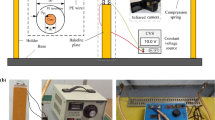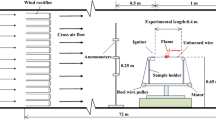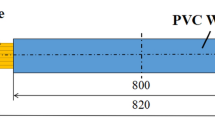Abstract
This paper describes the results of an experimental and numerical study of the effect of electric current on the ignition and flame propagation propensity of polyethylene-insulated copper conductor electrical wire. Two simplified models were developed to describe the ignition and steady flame propagation of energized electrical wires exposed to an external heat flux, respectively. The models predict that for a higher-conductance wire it is more difficult to achieve ignition and flame propagation. Experiments were performed on three types of electrical wires with different conductor diameter of 0.5 mm, 0.8 mm and 1.1 mm and the same insulation thickness of 0.15 mm. A 20 mm long coil heater was used as the ignition source to generate a controlled heat flux. Experiments show that increasing the current of wire leads to a convexly decreasing critical heat flux for ignition, agreeing with model predictions. Effects of different currents on insulation temperature and flame height are discussed. The flame width of three types of wires could be considered invariable with the current, which are 9.06 mm, 12.45 mm and 15.07 mm respectively. The heat release rate of flame is discussed through the volume of flame and a correlation is presented that ΔV F ∝ I 2. The likelihood for molten PE dripping is determined by the absolute and relative fuel load for different wires. Finally, the correlation between the flame propagation velocity and the current of wire, Δv f ∝ I 2, is demonstrated.









Similar content being viewed by others
References
Yu J et al (2013) China fire services 2013. China Personnel Press, Beijing
Residential building electrical fires (2009-2011) (2014) Topical Fire Report Series 14:1–11
Keski-Rahkonen O, Mangs J (2002) Electrical ignition sources in nuclear power plants: statistical, modelling and experimental studies. Nucl Eng Des 213:209–221
Thomas E (1992) Electric services and building fires. Fire Technol 28:70–86. doi:10.1007/BF01858052
Andersson P, Rosell L, Simonson M, Emanuelsson V (2004) Small and large scale fire experiments with electric cables under well-ventilated and vitiated conditions. Fire Technol 40:247–262. doi:10.1023/B:FIRE.0000026879.07753.86
Electrical wire insulation flammability test. NHB 8040.1C, NASA, 1991
Fernandez-Pello AC, Hasegawa HK, Staggs K, Lipska-Quinn AE, Alvares NJ (1991) A study of the fire performance of electrical cables. Fire Saf Sci 3:237–247
Leung C, Staggs J, Brindley J, McIntosh A, Whiteley R (2000) The effects of an inert central core on the thermal pyrolysis of an electrical cable. Fire Saf J 34:143–168
Umemura A, Uchida M, Hirata T, Sato J (2002) Physical model analysis of flame spreading along an electrical wire in microgravity. Proc Combust Inst 29:2535–2543
Kikuchi M, Fujita O, Ito K, Sato J, Sakuraya T (1998) Experimental study on flame spread over wire insulation in microgravity. Proc Combust Inst 27:2507–2514
Fujita O, Nishizawa K, Ito K (2002) Effect of low external flow on flame spread over polyethylene-insulated wire in microgravity. Proc Combust Inst 29:2545–2552
Nakamura Y, Yoshimura N, Ito H, Azumaya K, Fujita O (2009) Flame spread over electric wire in sub-atmospheric pressure. Proc Combust Inst 32:2559–2566
Huang X, Nakamura Y, Williams FA (2013) Ignition-to-spread transition of externally heated electrical wire. Proc Combust Inst 34:2505–2512
Takahashi S, Takeuchi H, Ito H, Nakamura Y, Fujita O (2013) Study on unsteady molten insulation volume change during flame spreading over wire insulation in microgravity. Proc Combust Inst 34:2657–2664
Hu L, Zhang Y, Yoshioka K, Izumo H, Fujita O (2014) Flame spread over electric wire with high thermal conductivity metal core at different inclinations. Proc Combust Inst. doi:10.1016/j.proci.2014.05.059
Rodak EM, Taylor RJ, Hirsch DB, Linley LJ (1994) Effects of sample and test variables on electrical wire insulation flammability. J Test Eval 22:449–452
Cahill P (1995) Electrical short circuit and current overload tests on aircraft wiring. USDT, DOT/FAA/CT-TN94/55
Apostolakis GE, Catton I, Issacci F, Jones S, Paul M, Paulos T, Paxton K (1995) Risk-based spacecraft fire safety experiments. Reliab Eng Syst Safe 49:275–291
Fujita O, Kyono T, Kido Y, Ito H, Nakamura Y (2011) Ignition of electrical wire insulation with short-term excess electric current in microgravity. Proc Combust Inst 33:2617–2623
Linteris GT (2011) Clean agent suppression of energized electrical equipment fires. Fire Technol 47:1–68
Nakamura Y, Yoshimura N, Matsumura T, Ito H, Fujita O (2008) Flame spread over polymer-insulated wire in sub-atmospheric pressure: similarity to microgravity phenomena. In: Progress in scale modeling. Springer, New York
Takahashi S, Takeuchi H, Ito H, Nakamura Y, Fujita O (2013) Study on unsteady molten insulation volume change during flame spreading over wire insulation in microgravity. Proc Combust Inst 34:2657–2664
Delichatsios MA, Altenkirch RA, Bundy MF, Bhattacharjee S, Tang L, Sacksteder K (2000) Creeping flame spread along fuel cylinders in forced and natural flows and microgravity. Proc Combust Inst 28:2835–2842
Cohen JD, Finney MA (2014) Fine fuel particle heating during experimental laboratory fires. Imprensa da Universidade, Coimbra.
Churchill SW, Chu HHS (1975) Correlating equations for laminar and turbulent free convection from a horizontal cylinder. Int J Heat Mass Transfer 18:1049–1053
Brandrup J, Immergut EH, Grulke EA, Abe A, Bloch DR (2005) Polymer handbook. 4th edn. Wiley, New York
Quintiere JG (2006) Fundamentals of fire phenomena. Wiley, New York
Alenitsyn AG, Butikov EI, Kondraryez AS (1997) Concise handbook of mathematics and physics. CRC Press, Boca Raton
Jinno D, Gupta AK, Yoshikawa K (2002) Thermal destruction of plastic materials in solid waste. In: ITC on Coal Utilization and Fuel Systems Clearwater
Green AES, Sadrameli SM (2004) Analytical representations of experimental polyethylene pyrolysis yields. J Anal Appl Pyrolysis 72:329–335
Torero JL, Vietoris T, Legros G and Joulain P (2002) Estimation of a total mass transfer number from the standoff distance of a spreading flame. Combust Sci Tech 174:187–203
De Ris J (1979) Fire radiation—a review. Proc Combust Inst 17:1003–1016
Orloff L, De Ris J (1982) Froude modeling of pool fires. Proc Combust Inst 19:885–895
Author information
Authors and Affiliations
Corresponding author
Rights and permissions
About this article
Cite this article
Wang, X., He, H., Zhao, L. et al. Ignition and Flame Propagation of Externally Heated Electrical Wires with Electric Currents. Fire Technol 52, 533–546 (2016). https://doi.org/10.1007/s10694-015-0515-9
Received:
Accepted:
Published:
Issue Date:
DOI: https://doi.org/10.1007/s10694-015-0515-9




